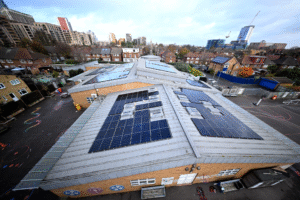A new system designed by Colas aims to generate electricity from solar photovoltaic panels embedded in the road surface. It might sound like science fiction, but the Wattway system is currently being tested in France and the USA, and is the result of five years’ research by the international infrastructure company and the French National Institute for Solar Energy. The company estimates 20m² of Wattway panels could provide enough electricity to power a single home. If the system proves successful, it could open up a previously untapped source of renewable energy.
Jamie Hailstone spoke to Philippe Harelle, chief technology officer at Colas SA’s Wattway unit, to find out more.
In a nutshell, how does the Wattway system work?
Wattway is a solar-panel-road, which means that the road is covered by solar panels, which capture solar energy and transform it into electricity. Then, the electricity produced can be used for any applications for which electricity is required. Moreover, the added value to the electricity generated by Wattway, is that it is renewable energy.
What are the benefits of putting solar cells in a road, as opposed to putting them on a rooftop?
Wattway has no intention of competing with roof-top solar panels or solar parks to replace these solutions. Wattway is an additional solution to help ensure an environmentally-friendly transition towards renewable energy. The benefit of putting solar cells on a road is to give a second function to the road. Moreover, the surface available all around the world is huge.
In urban areas, Wattway can provide a source of electricity that is very close to where consumption is the highest. It is perfectly suited to new usages (electric vehicles etc) and contributes to the transition phase towards environmental-friendly solutions and Smart Cities.
In rural areas, Wattway can be used in areas where it is difficult and costly to hook up to the electricity grid. It is a local, long-lasting source of short circuit renewable energy.
How do you protect the solar PV cells from being damaged by traffic?
Each panel contains 15-cm wide cells making up a very thin film of polycrystalline silicon that transforms solar energy into electricity. These extremely fragile photovoltaic cells are coated in a multilayer substrate, translucent enough to allow sunlight to pass-through, and resistant enough to withstand truck traffic.
The surface that is in contact with vehicle tyres is treated to ensure skid-resistance and is equivalent to conventional asphalt mixes.
In this perfectly watertight layer, the electrical system is designed to ensure that the entire system does not short circuit if one cell is down. Electrical connections can be hooked up on the side of traffic lanes, in small trenches or in ducts integrated in the panels themselves. Lastly, electronic circuit breakers ensure safety.
How much energy can a small stretch of Wattway road generate, and how much would this increase for longer roads?
Each pilot site is unique.
The quantity of energy generated depends mostly on the geographic location. For instance, In Vendée Région (Western France), the estimated amount of electricity produced for a 50m² pilot site, will vary between 5,200 kWh and 6,300 kWh per year, whereas in West Point, Georgia (USA) it is estimated at 7,000 kWh per year.
How does a Wattway road compare to traditional road surfaces in terms of longevity, wear and tear etc?
Further to the laboratory tests, the Wattway solar road lifetime is identical as a conventional road (at least 10 years depending on the traffic density which accelerates its wear). If a road is under used, we estimate that nothing prevents Wattway from having a lifetime around 15 years, like a regular road. The experimental phase Wattway is currently conducting is made to check if the laboratory tests and results are the same in real life.
Presumably, the Wattway system is more expensive than an ordinary road surface. How quickly would a system like this pay for itself through electricity generation?
We are currently launching pilot projects; we are not in the marketing phase. Each project is handled as a single unit with custom-made solutions. We are working on high-tech, turnkey projects. Therefore it is too soon to discuss commercial pricing and return on investment.
Is this system only suitable for new developments or could it be added to existing roads easily?
This system is designed to be added easily on existing roads without any construction work. Wattway’s solar panels are simply glued on the road. The system can also be part of new development projects as it will be handled at the end of the construction.
Could it also be used for pavements?
Pavements can also be part of the experimental phase if they are in the sun.
The system is currently being trialled in France, but can you also see it being rolled out in other countries, such as the UK?
The system is not only trialled in France, we have inaugurate a new Wattway solar road in Georgia, USA last December. We are currently studying several dozens of projects in France and worldwide. Projects are selected according to several criteria such as, for instance, climate and traffic conditions.
Images: © COLAS – Joachim Bertrand

















This system would be much better suited to walkways and piazza’s where there would be much less loading and wear and less shading from people on the move.